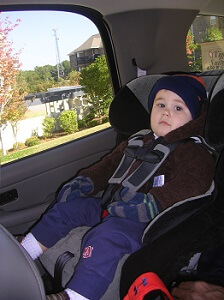Alabama Child Restraint Law (2006)
“Every person transporting a child in a motor vehicle operated on the roadways, streets, or highways of this state, shall provide for the protection of the child by properly using… a child passenger restraint system.” The term “motor vehicle” as used in this section shall include a passenger car, pickup truck, van (seating capacity of 10 or less), minivan, or sports utility vehicle. The fine for a citation is $25.00. The size-appropriate restraint system required for a child shall include all of the following types of child safety seats. Protect your children by changing each seat as they grow.
Helpful links:
- Changes in Alabama’s Child Restraint Law
- Car Seat Recommendations (NHTSA)
- Algorithm to guide the implementation of best-practice recommendations for optimal child passenger safety(American Academy of Pediatrics)
1. Rear-Facing Only Seats and Rear-Facing Convertible Seats (Infants/Toddlers)
- All infants and toddlers should ride in a Rear-Facing Car Seat until they are 2 years of age or until they reach the highest weight or height allowed by their car safety seat’s manufacturer.
- Never put a rear-facing car seat in the forward-facing position or in front of an active airbag.
- Ensure that the harness is snug and that the harness clip is placed at the center of the chest and at the level of the child’s armpits.
- The seat must be tightly secured using the vehicle lap belt or anchored using the LATCH System.
2. Convertible Seats and Forward-Facing Seats with Harness (Toddler/Preschoolers)
- All children 2 years or older, or those younger than 2 years who have outgrown the rear-facing weight or height limit for their car seat, should use a Forward-Facing Car Seat with a harness for as long as possible, up to the highest weight or height allowed by their car seat’s manufacturer.
3. Booster Seats (School-Aged Children)
- All children whose weight or height is above the forward-facing limit for their car seat should use a Belt-Positioning Booster Seat until the vehicle seat belt fits properly, typically when they have reached 4 feet 9 inches in height and are between 8 and 12 years of age.
- Use belt-positioning booster seats with lap and shoulder belts (seat belts fit properly when the lap belt lays across the upper thighs and the shoulder belt fits across the chest).
- Use high-back booster seats in vehicles with low seat backs.
- Only use low-back booster seats if the child’s ears are below the top of the seat back when seated.
- Use until the child’s feet can touch the floor with knees bent at the edge of the seat and the back is straight against the seat back.
- Raises the child up so the safety belt fits the way it is designed for an adult passenger.
4. Seat Belts (Older Children)
- When children are old enough and large enough to use the vehicle seat belt alone, they should always use Lap and Shoulder Seat Belts for optimal protection. All children younger than 13 years should be restrained in the rear seats of vehicles for optimal protection.
- The lap belt lays across the upper thighs and the shoulder belt fits across the chest.

